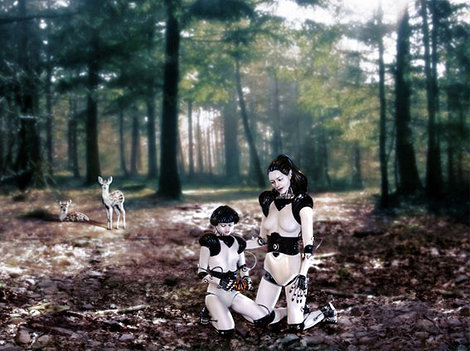
Continuing through October 31, 2013
This provocative exhibition addresses the subliminal intrusion of our subconscious desires into our conscious selves. Based loosely on the Emily Dickinson poem: “How strange that nature does not knock, and yet does not intrude,” the show presents work by eight female artists — from emerging to established. The George Gallery, named after the pseudonym (George Sand) of 19th-century writer Aurora Dupin, shows women artists only, preferably with a challenging point of view. The pieces in this exhibition are among the 19-month-old gallery’s most explicitly sexual and/or subversive.
Marilla Palmer’s multi-media “Nature Doesn’t Knock,” providing the title for the show, is a drawing of two fluid branches with a variety of leaves and flowers. It is a seemingly prosaic work, but one constructed of ink, spores, holographic vinyl, pressed leaves and flowers on paper. “One True Leaf” and “Glowing Symmetry” are collages with watercolor, velvet, thread, sequins and more. While depicting different kinds of plant life, Palmer’s works, in which the media is part of the message, indicate that human nature, while instinctual, is tempered by the material world.
Japanese American Michiko Yao’s ”Lily” appears at first as a magnificent white creation, inspired by Japanese flower paintings. Different versions of this lily, including a time-lapse video, incorporate colloidal liquids in pink and light blue, flowing down the flower petals and besmirching them, referencing sexual acts popularized in Japanese pornography. Her print of “Still Life with Flowers,” also with sexual overtones through the opening of its flowers, is like a classic Dutch still-life; but it is a photograph of artificial flowers.
Mary Jones contributes two exquisite mixed media paintings of abstract flowers to this show. “Day and Night” and “The Rebellious Flower Turned Away” each feature two flowers, one of which is a large open lotus. While the lotus flower has various interpretations, including cause and effect, purity of mind and spirit, and the opening of the self to the world, Jones’ versions also have sexual variations with colorful swirling energy dominating the canvasses. The women, animals and symbols in Susan Jamison’s allegorical egg tempera paintings, as she explains, “are taken from personal narratives, myths, fairy tales and dreams.“ Her “We Are Beautiful,” a profile of a head and nude torso emblazoned with pink tattoos and snakes, is an example. She adds, “I play with concepts of interior and exterior beauty by replacing my character’s face with a medical illustration of the veins in the head in contrast with her skin, which is decorated with a hyper-feminine, hot pink flowery pattern.”
The most overtly sexual works in this exhibition are Jenny Toth’s surreal collaged and etched watercolors. Two paintings feature naked women anticipating and aware of men looking at them, both set in off-kilter environments. Her “Beak to Beak” is of two stylized females, each with a grotesque beak for a face; “Birthing a Cactus,” even more horrifying, features a nude woman wearing a rhinoceros mask giving birth to a huge prickly cactus. Equally sexy but more restrained is Carla Gannis’ “Nature Story,” a collaged and Photoshopped dreamscape of two robotic women wearing sexy black and white space suits. The pair are watched by two deer in the forest. It is like a still from a sci-fi thriller with sexual undertones, as the deer exemplify the self-contained women’s unconscious desires. Sandra Bermudez’s “Heroin,” composed of die-cut Plexiglas and transfer etching with acrylic, is a baroque-styled wreath that contains actual bits of the illicit drug, along with ivy and dried poppies (the flower that is used to extract the drug). This deceptively elegant work alludes to the growing of the poppy by impoverished farmers in third-world countries, particularly in Colombia, where the artist is from. It also expresses how the darker side of human nature can spring from what initially appears to be beautiful and positive.
The youngest artist in the show, Suzanne Walsh, creates detailed, layered work on panel, using pyrography (controlled burning of the wood), graphite drawing and oil. Her portrayal of aggressive animals, symbolizing the conflict between our primal and societal selves, include a fox in “Predator Instinct” and a startled owl with mice on its head in “Ghost Mice Ready for Takeoff.” As an emerging artist, Walsh has a studied technique and uncanny sense of what lies beneath our exteriors; her body of work already portends a detailed examination of issues that reference the human condition. In fact, all of the artists in this exhibition look deep within themselves to depict concerns related to our larger, conflicted world.
